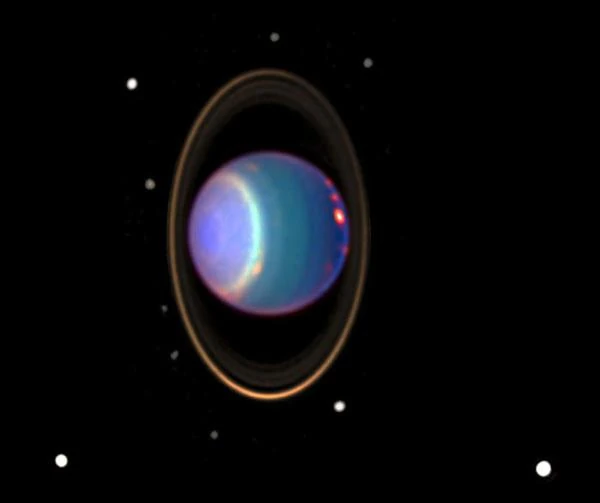
Image: Most planets rotate on an axis almost perpendicular to the ecliptic plane, but Uranus' axis is almost parallel to this plane. It seems to 'roll' in its orbit. Uranus is surrounded by its four main rings and 10 of its 27 known moons in this color view that uses data taken by the Hubble Space Telescope in 1998. A study with new modeling shows that four of Uranus' large moons likely contain internal oceans.
Image credit: NASA/JPL/STScI.
The visual appearance of Uranus reflects the presence at high altitude of photochemical hydrocarbon clouds that overlay methane haze, which in turn overlies hydrogen sulfide or ammonia clouds.
Tilt of the axis: Uranus is the only planet in the solar system whose axis of rotation is extremely tilted. It is practically lying on its side, with an inclination of nearly 98 degrees relative to its orbital plane. Each pole of the planet is plunged into total darkness for a period of 42 Earth years. This means that in 84 Earth years, orbital period around the Sun, its poles receive about 42 years of continuous sunshine, followed by 42 years of continuous darkness. The exact origin of the tilt of the axis of rotation of Uranus remains a subject of debate among scientists. A common hypothesis is that a major impact with a massive celestial body at an early stage in Uranus' history could have caused this extreme tilt.
Blue-Green Color: Uranus exhibits a distinct unique blue-green color due to the presence of methane in its atmosphere.
Thick atmosphere: The atmosphere of Uranus is composed mainly of hydrogen (about 83%) and helium (about 15%), with traces of methane, ammonia, water and other volatile compounds. However, it is less thick than that of Jupiter and Saturn.
Rings: Uranus has rings, although less spectacular and less visible than those of Saturn. The rings of Uranus, designated by letters of the alphabet, are mainly composed of small particles of ice, dust and rocky debris. They are much less massive and less extensive than Saturn's rings. Uranus' rings are often described as dark or poorly reflective. Their low luminosity makes them more difficult to detect and observe from Earth. Some of Uranus' rings are influenced and held in place by small moons called "shepherd moons". These moons orbit near the edges of the rings and exert a gravitational influence that keeps particles in the rings from scattering.
Storms and Turbulent Weather: Uranus experiences severe storms and turbulent weather, including strong winds reaching speeds of over 900 km/h. One of the most notable features of Uranus storms is the presence of a large dark patch on the planet's atmosphere. This spot, also known as the "far southern dark spot", was first observed by the Voyager 2 probe in 1986. It is similar to Jupiter's Great Red Spot, but darker in color. Uranus experiences very fast atmospheric winds, with speeds of up to 900 km/h.
Unusual magnetosphere: Uranus' magnetic axis is tilted relative to its axis of rotation. While most planets have their magnetic axis aligned with their axis of rotation, Uranus exhibits a significant tilt of nearly 60 degrees. This means that the magnetic pole of Uranus is almost in the plane of its orbit around the Sun.
Fast Rotation: Uranus has a rotation period of almost 17 hours and 14 minutes. This means that a day on Uranus lasts 17 hours and 14 minutes. The unusual tilt of the axis of rotation of Uranus has consequences on its rotation. At certain times of the Uranian year, one of the planet's poles is permanently turned towards the Sun, while the other pole is in darkness. This creates extreme seasons and significant temperature variations on the planet but the average temperature is -224°C, the lowest of any planet in the solar system.
Moons: Uranus has 27 known moons. The names of the moons of Uranus were inspired by characters from Shakespeare's plays.
- Miranda is one of the most fascinating moons of Uranus. It presents a highly fractured surface, with steep cliffs, valleys and craters. Scientists believe these features are the result of past geological activity, such as episodes of tectonic movement and internal warming.
- Titania is the largest moon of Uranus and the eighth largest moon in the solar system. It has a varied landscape with craters, valleys and plains. Clues suggest that it could harbor an underground ocean.
- Oberon is the second largest moon of Uranus. It presents a surface covered with impact craters, indicating a geologically inactive past. Oberon is believed to have a rocky core surrounded by a layer of ice.
- Umbriel is a dark, low-reflective moon of Uranus. It is characterized by impact craters and ditches, testifying to its geological history. Umbriel is one of the oldest moons in the solar system.
- Ariel is a moon of Uranus that features relatively smooth plains as well as crater and valley formations. Signs of past geological activity, such as rifts and fault lines, have also been observed on its surface.
- Puck is a small moon of Uranus which has an eccentric and inclined orbit with respect to the equatorial plane of the planet. Its surface is covered with impact craters.
1986: In 2023, no space mission was specifically launched to Uranus. The only space mission to have visited Uranus was the Voyager 2 probe, which flew by the planet in 1986. It provided valuable images and data on Uranus and its system.